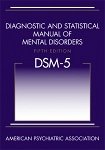David Baxter PhD
Late Founder
The DSM-5 has been finalized
by Vaughan Bell
December 2, 2012

It?s arcane, contradictory and talks about invisible entities which no-one can really prove. Yes folks, the new psychiatric bible has been finalist.
The American Psychiatric Association have just announced that the new diagnostic manual, to be officially published in May 2013, has been approved by the board of trustees.
You can read the official announcement and a summary of the major changes online as a PDF ? and it seems a few big developments are due.
? and it seems a few big developments are due.
The various autism-related disorders have been replaced by a single ?autism spectrum disorder? ? essentially removing Asperger?s from the manual.
A ?disruptive mood dysregulation disorder? has been added to ?diagnose children who exhibit persistent irritability and frequent episodes of behavior outbursts three or more times a week for more than a year?.
As the APA admit, this is largely to address the rise of the ?childhood bipolar disorder? concept which has led to a huge number of children with challenging behaviour being medicated on rather ill-defined grounds. Whether this actually does anything to change this, is another matter.
Despite the expected revision of the overly complex and often indistinguishable subtypes of personality disorder ? these have been kept as they were.
Post-traumatic stress disorder has been tinkered with ? apparently to pay ?more attention to the behavioral symptoms? and presumably to exclude ?PTSD after seeing things on the TV? ? a change included in all the drafts.
Perhaps most controversially, the bereavement exclusion will be removed from the diagnosis of depression ? meaning you could be diagnosed and treated for depression just two weeks after a loss if you fulfil the diagnostic criteria.
If you want to examine the changes yourself ? tough luck ? the APA have removed all the proposed criteria off the DSM-5 website. This is supposedly to ?avoid confusion? but most likely because the manual is a big money-maker and the finished product will be on sale in May 2013.
But diagnostic developments aside, we can also expect some changes simply from the benefit of hindsight.
Most clinicians will learn enough of the new manual to ensure they look cutting-edge for a few months after publication and then ignore the new diagnoses and use the same ones they?ve always had vaguely stored in their heads.
Researchers will go through an extended period of academic willy waving where they attempt to outdo each other through their wide and extensive knowledge of dull and irrelevant details.
The APA will keep underlining how we?re now in a new era of science thanks to the science behind the new manual of science that turns everything it touches into pure, definitely not insecure, science.
And finally, the chairman of the DSM-5 committee will begin the traditional process of becoming disillusioned and publicly denouncing each step in the development of the DSM-6.
It?ll be as if the past never happened.
by Vaughan Bell
December 2, 2012

It?s arcane, contradictory and talks about invisible entities which no-one can really prove. Yes folks, the new psychiatric bible has been finalist.
The American Psychiatric Association have just announced that the new diagnostic manual, to be officially published in May 2013, has been approved by the board of trustees.
You can read the official announcement and a summary of the major changes online as a PDF
 ? and it seems a few big developments are due.
? and it seems a few big developments are due.The various autism-related disorders have been replaced by a single ?autism spectrum disorder? ? essentially removing Asperger?s from the manual.
A ?disruptive mood dysregulation disorder? has been added to ?diagnose children who exhibit persistent irritability and frequent episodes of behavior outbursts three or more times a week for more than a year?.
As the APA admit, this is largely to address the rise of the ?childhood bipolar disorder? concept which has led to a huge number of children with challenging behaviour being medicated on rather ill-defined grounds. Whether this actually does anything to change this, is another matter.
Despite the expected revision of the overly complex and often indistinguishable subtypes of personality disorder ? these have been kept as they were.
Post-traumatic stress disorder has been tinkered with ? apparently to pay ?more attention to the behavioral symptoms? and presumably to exclude ?PTSD after seeing things on the TV? ? a change included in all the drafts.
Perhaps most controversially, the bereavement exclusion will be removed from the diagnosis of depression ? meaning you could be diagnosed and treated for depression just two weeks after a loss if you fulfil the diagnostic criteria.
If you want to examine the changes yourself ? tough luck ? the APA have removed all the proposed criteria off the DSM-5 website. This is supposedly to ?avoid confusion? but most likely because the manual is a big money-maker and the finished product will be on sale in May 2013.
But diagnostic developments aside, we can also expect some changes simply from the benefit of hindsight.
Most clinicians will learn enough of the new manual to ensure they look cutting-edge for a few months after publication and then ignore the new diagnoses and use the same ones they?ve always had vaguely stored in their heads.
Researchers will go through an extended period of academic willy waving where they attempt to outdo each other through their wide and extensive knowledge of dull and irrelevant details.
The APA will keep underlining how we?re now in a new era of science thanks to the science behind the new manual of science that turns everything it touches into pure, definitely not insecure, science.
And finally, the chairman of the DSM-5 committee will begin the traditional process of becoming disillusioned and publicly denouncing each step in the development of the DSM-6.
It?ll be as if the past never happened.
